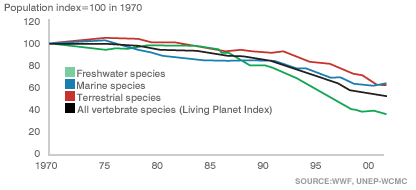Recent data from the Millennium Assessment suggests that there’s some unseen agents at work contributing to the decline of historic wildlife populations and species. Man is the root cause, but the conversion of land to agrarian usage replaces resident wildlife with an artificial ecosystem that is less diverse.

Scientists suggest the increased conversion of land in developing countries is assisting in the demise of native species due to a double stressor; domestic plants and animals are removed, and new commercial species are introduced. Historic populations fall and the commercial species compete with what’s left.
Sampling of these areas suggest that what survives is both smaller and fewer.
Genetic diversity is on the decline worldwide across all species; plants, animals, and fish. Research suggests that diversity is one of the least understood effects, as the loss of one species usually accelerates the rise, or fall, of others.
The rise of democratic governments has opened additional areas to trade, and with trade comes the same species everyone else is using for grains and meats; commercial crops are becoming less diverse as well, an issue of equal concern.
It’s an interesting read, suggesting that we need to set aside additional “preserves” on land and sea, to ensure our continued well being.
Technorati Tags: genetic diversity, Millennium Assessment

The idea of “preserves” still feels like such a last-ditch effort to me — little islands of diversity while we still rage like crazy all around. And this was a thing Rachel Carson cautioned against in her seminal environmental writing, “The Silent Spring”. It worries me that both corporate interests, and the current administration are enamored of this approach, as it may be the appearance of “doing something” allowing them to sidestep from the only real choice we may have, which is moving toward an almost total integration of our living systems into the entire biosystem, and assuming the stewardship role in all decisions concerning it. I don’t know though. We’re up against the wall now.
I’d say your assessment is completely accurate. We are up against the wall, and it’s going to take a great deal of discomfort to set the ship onto a different course. Preserves are “islands of fish life” at best, it may preserve some brood stock, but that is all it will do.
The Bluefin Tuna squabble in the Mediterreanean is a classic example, they still haven’t got everyone to agree to reduce the take, even though only 3% of the historic population remains.
Painful to watch.
Yup, very painful. And your Bluefin example is sadly emblematic of the situation. Couple of examples that reduce me to tears of pessimism are the Diablo Nuclear and Morro Bay fossil fuel power plants, both operating within the boundaries of the new MPA’s, sucking fish larvae 24-7 while fishermen are excluded. And the “preserves” will do nothing to stop or ameliorate what we just saw happen in San Francisco Bay. Like everything else lately – bizzarro.